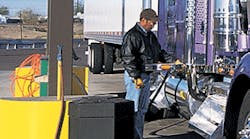The transition from the current 500 parts per million (ppm) diesel to 15 ppm ultra low sulfur diesel (ULSD)-- set to be complete at retail terminals by Oct. 15-- is expected to bring spot shortages as well as a one to five-cent price production premium, warned industry experts who spoke during a ULSD conference call hosted by investment firm Bear Stearns.
“One way of looking at [the ULSD transition] is as a planned hurricane coming down the pike,” said Joe Broski, YRC Worldwide senior manager of commodity procurement. Not only is the transition deadline during the hurricane season, it will come when diesel prices seasonally tick upward as oil markets gear up to supply heating oil—which is essentially high-sulfur diesel.
Broski is concerned that there will be shortages of winter blend ULSD despite the Oct. 15 deadline. Markets identified as being most as risk for spot shortages are the Northeast region and Chicago, as well as areas where home heating oil use is high. The 3,000 ppm sulfur content of heating oil presents logistical challenges for supplying ULSD. The Mountain states, as well as Atlanta, GA, Memphis, TN and Nashville, TN, are considered at-risk markets, Broski noted.
“Many of the refiners in [the Northeast] are stopping the blending of diesel altogether and just becoming heating oil producers,” Broski said.
YRC Worldwide is anticipating that some spot markets could see a 10 to 20 cent per gallon premium as a result of shortages of on spec ULSD.
“It’s not an issue at the refining standpoint—the issue is logistics,” said Gary Russell, investor relations specialist at ConocoPhillips. “[This is especially true] with diesel because you have to produce product at a spec much lower than what’s required because of the potential for contamination issues. The diesel has to maintain a 15 ppm spec all the way through the distribution channel. Post-October 15, anything above 15 ppm is not ULSD.”
For now, YRC Worldwide is focused on adapting its fuel infrastructure to secure consistent supplies. “Our strategy is to make sure were covered from pricing and more importantly from a supply standpoint,” Broski said. “We have plans A, B, and C anticipating spot shortages-- not nationwide, but knowing that some markets will be tighter than others.”
Interestingly, ConocoPhillips pointed out that until 2010, retailers are permitted to sell both 500 ppm diesel and ULSD. According to Russell, retailers have an “unlimited” capacity to downgrade off-spec ULSD to mix in with 500 ppm diesel.
Pre-’07 engines would be able to run on both ULSD and 500 ppm diesel whereas ’07 engines—which are required to emit lower emissions— must run on ULSD only. However, because refiners are required to supply the lion’s share of diesel fuel as ULSD, this will effectively turn 500 ppm into a boutique fuel, Broski noted. “And boutique fuels are equated with higher prices,” Broski said.
According to Broski, by October 15, the trucking industry will have 0.1% active tractors with engines that meet the ’07 emissions requirement and by 2015 that number will jump to 50%. This leaves plenty of potential demand for 500 ppm diesel, which could put some upward pressure on ULSD.
YRC Worldwide said it has no plans for pre-buying trucks to delay purchases of trucks that meet the ’07 emission requirements.
“We don’t have a quick turn cycle…[so] our conversion to ‘07 will be a bit more muted than other fleets,” said Broski. “We’ve tried to maintain a fairly reasonable equipment flow. We’re not doing anything drastically different from what we’ve done in past.”



